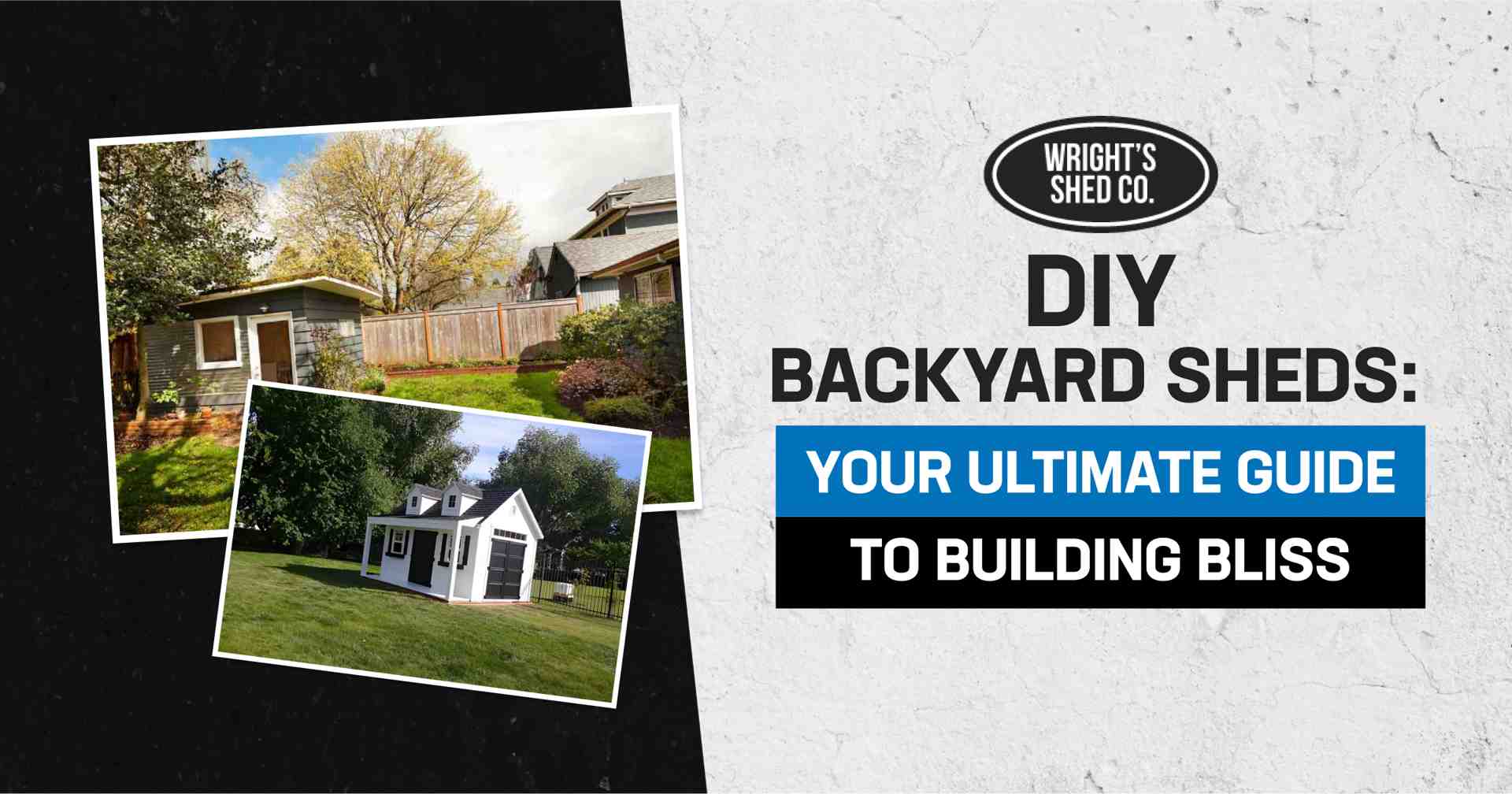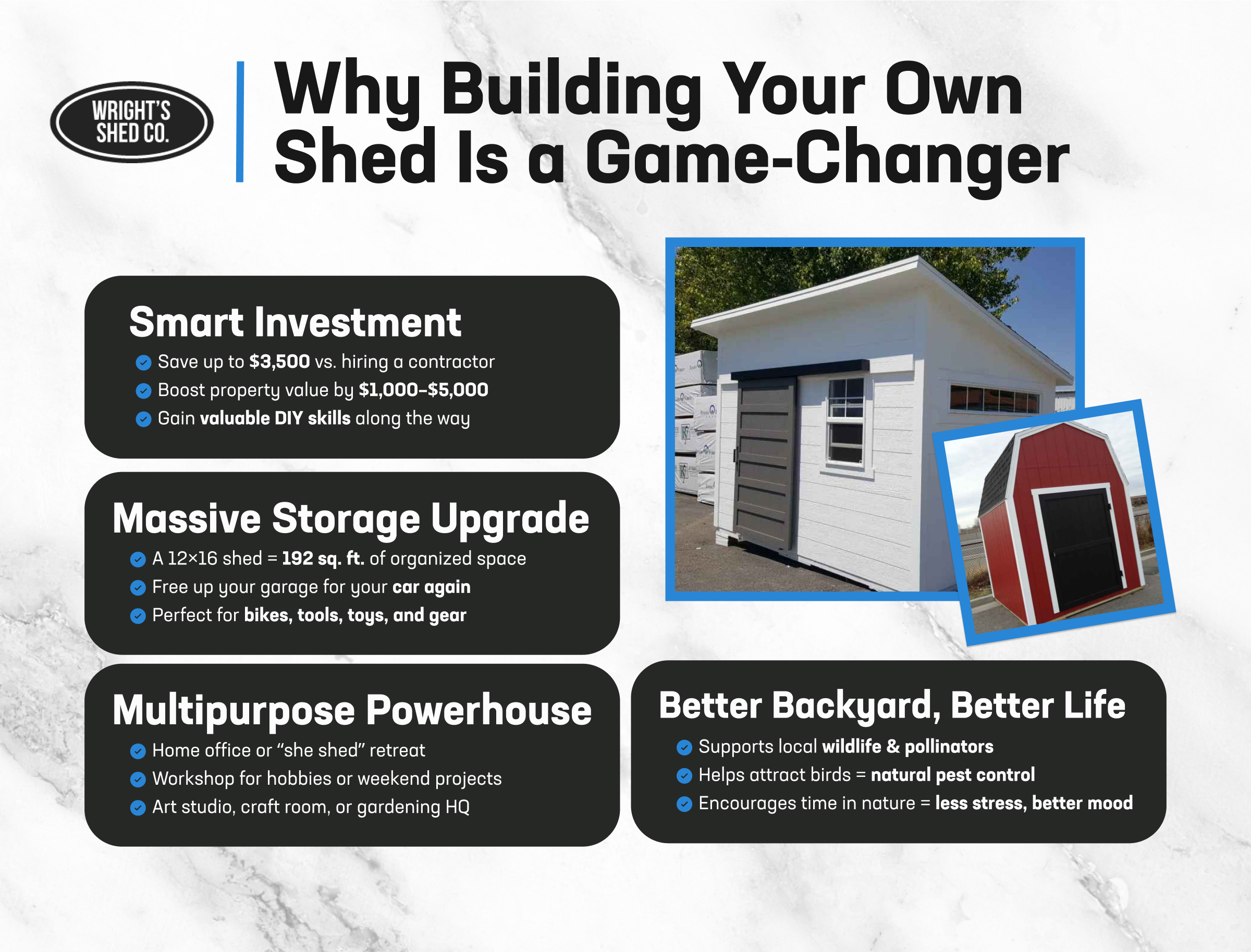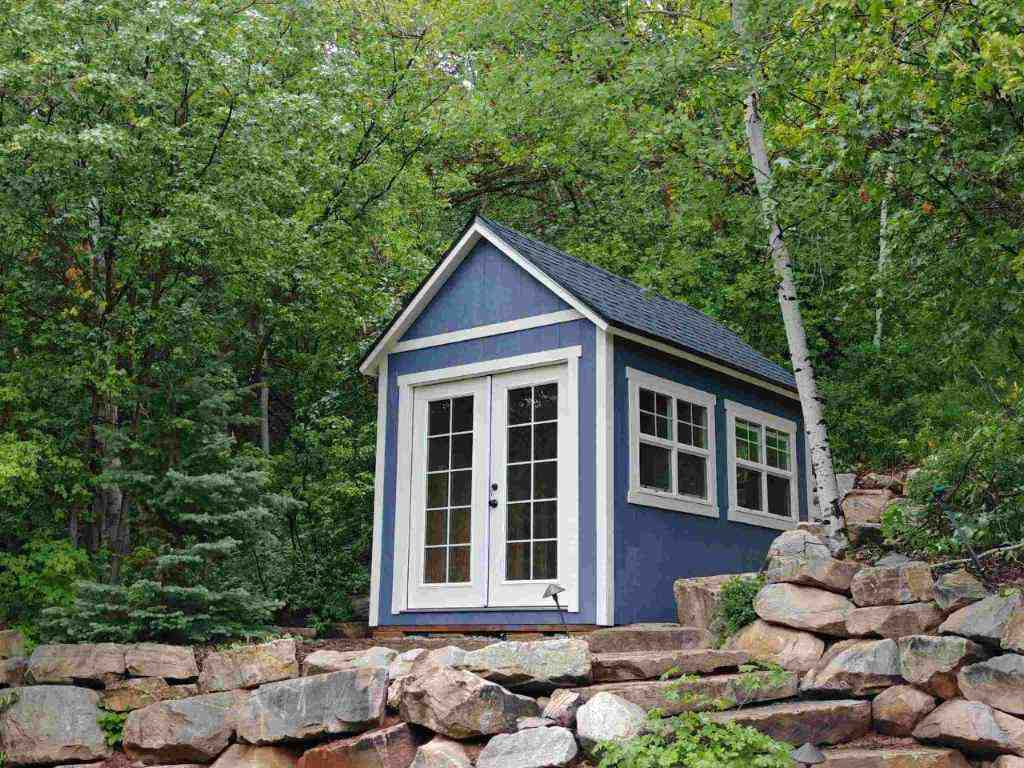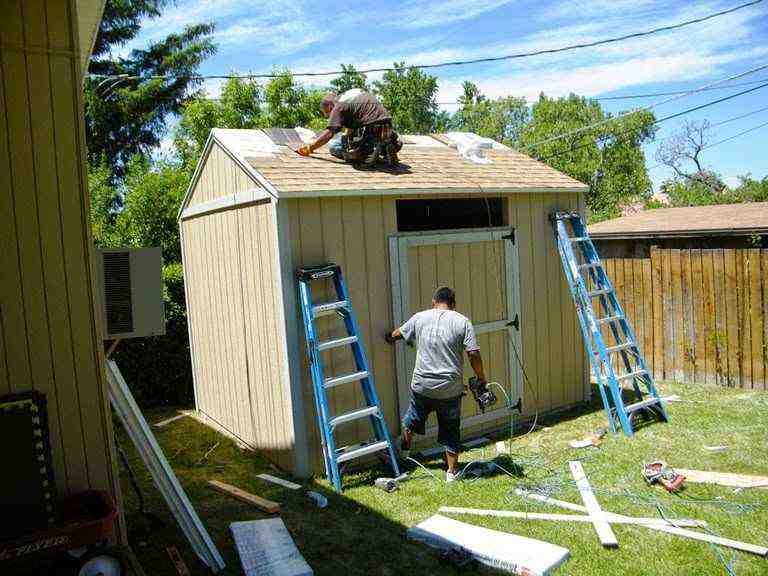Why DIY Backyard Sheds Are the Ultimate Storage Solution
DIY backyard sheds offer homeowners an affordable way to add storage, workspace, and property value to their home. Whether you’re looking to declutter your garage, create a home office, or build a workshop, building your own shed can save thousands compared to hiring contractors.
Quick DIY Backyard Sheds Options:
- DIY Shed Kits: Pre-cut lumber with instructions – assemble in 8-12 hours.
- Free Plans: Download blueprints for $17-24 per square foot in materials.
- Premium Plans: Detailed guides with cut lists and step-by-step photos.
- Panelized Walls: Pre-built sections that snap together like building blocks.
Popular DIY shed uses include:
- Garden tool storage
- Home office or “she shed”
- Workshop space
- Bike and sports equipment storage
- Hobby room or art studio
You don’t need advanced carpentry skills. Modern shed kits use simple “Lincoln log” construction methods that even beginners can master. One customer assembled her entire shed while her husband was at work – his surprised reaction was priceless.
Top Reasons to Build Your Own Shed
Building your own shed is one of the smartest home improvement decisions you’ll make. The potential savings of up to $3,500 compared to hiring contractors is compelling, but there’s much more to the story.
The storage boost alone will change how you use your property. A 12×16 shed gives you 192 square feet of organized space – enough to finally park your car in the garage again! DIY backyard sheds can become incredible spaces that go way beyond storage.
I’ve seen sheds become home offices where parents can work without interruptions, cozy “she sheds“ for personal retreats, and fully-equipped workshops for weekend projects. One customer turned hers into an art studio and told me it became her favorite room on the entire property.
From a property value perspective, you’re looking at an increase of $1,000 to $5,000 depending on size and quality. When you factor in the money saved on materials and the skill-building experience, DIY shed construction becomes an investment that keeps paying dividends.
More info about tips on how to build a shed.
Multipurpose Magic
Modern DIY backyard sheds are like Swiss Army knives for your property – they adapt to whatever you need them to be.
Garden enthusiasts find their sheds become command centers for outdoor projects. Having dedicated space for garden tools, potting benches, and seasonal decorations transforms how you approach yard work.
Families find their sheds become the perfect home for bikes, sports equipment, and outdoor toys. A 10×12 shed easily accommodates multiple bicycles, camping gear, and those bulky items that clutter up garages.
The hobby room potential is where sheds really shine. Whether you’re into woodworking, crafting, or need quiet space for art projects, a dedicated shed workshop keeps messy activities separate from your living space.
Healthy Backyard Ecosystem
Building a DIY backyard shed creates opportunities to improve your entire outdoor environment. The area around your shed becomes prime real estate for pollinator-friendly plants that support local wildlife while beautifying your property.
Birds benefit tremendously from well-planned shed placement and landscaping. These natural pest controllers can eat nearly twice their body weight in insects per day. A strategically placed shed provides bird habitat and shelter while surrounding plants offer food sources.
The stress relief and mental health benefits of spending time in nature are incredible. Having a dedicated outdoor workspace gives you more reasons to connect with your environment.
Choosing & Planning DIY Backyard Shed Projects
Successful DIY backyard sheds begin with thoughtful planning. I’ve seen too many weekend warriors rush into projects only to find their “perfect” spot floods every spring or violates setback requirements.
Site selection sets the foundation for everything else. Look for level ground within 6 inches of true grade – any more and you’ll spend your weekend moving dirt instead of building. Good drainage is non-negotiable. That low spot that stays soggy after rain? Skip it.
Think about sun exposure and prevailing winds. A shed that bakes in afternoon sun becomes an oven in summer, while one that catches winter winds will be miserable to work in. Proximity to your house matters – you’ll appreciate that shorter walk when carrying tools in the rain.
Size rules can make or break your project budget and timeline. A 10×10 shed gives you 100 square feet – perfect for basic garden tools. Step up to 10×12 and you’ve got 120 square feet, enough for a riding mower plus organized storage.
For serious workshops or multi-use spaces, 12×16 sheds provide 192 square feet of real room to move around. The jump from cramped storage to comfortable workspace happens around this size.
Roof style affects both your shed’s personality and your building experience. Gable roofs offer that classic barn look with maximum headroom – perfect if you’re tall or plan to store larger items. Lean-to designs work beautifully against existing structures and use simpler framing that beginners find less intimidating.
Don’t let HOA codes and zoning setbacks surprise you after you’ve started building. Many areas require permits for structures over 120 square feet or 8 feet tall. A quick call to your local building department can save you from expensive do-overs.
More info about how to find the perfect storage shed for you
DIY Backyard Sheds for Small Yards
Small yards present unique opportunities rather than limitations. Structures under 100 square feet often fall into accessory building categories that require minimal or no permits.
An 8×8 shed provides 64 square feet of storage, which sounds tiny until you see how much fits inside with smart organization. Tool lockers and lean-to kits work particularly well in tight spaces and can often be completed in a single weekend.
Vertical storage becomes your secret weapon in small sheds. Wall-mounted tool organizers and overhead storage racks can double your usable space.
DIY Backyard Sheds for Multi-Use Spaces
Larger DIY backyard sheds open up exciting possibilities beyond simple storage. Office sheds have exploded in popularity since remote work became mainstream. A 10×12 or 12×16 shed provides enough space for a proper desk and storage without feeling cramped.
Converting a shed into a studio or guest cabin requires additional planning for insulation, electrical service, and climate control. Power requirements vary dramatically depending on intended use. Planning electrical service during the design phase saves you from expensive retrofitting later.
Product Roundup: Best DIY Shed Kits, Plans & Resources
When you’re ready to start your DIY backyard shed project, you’ll find options ranging from complete kits to detailed plans that guide you through building from scratch.
Shed kits offer the most straightforward path to success. These packages include pre-cut lumber, hardware, and step-by-step instructions that eliminate the guesswork. Panelized wall systems take convenience to the next level – these pre-built sections arrive ready to connect like giant building blocks.
For builders who want maximum control, free shed plans provide basic blueprints and materials lists. Premium plans bridge the gap for beginners, offering detailed instructions, color diagrams, and cut lists that guide you through each step.
Buying factory-direct can save you 25-35% compared to retail prices, and many manufacturers throw in free delivery and financing options.
Easiest Storage Shed to Build
If you’re new to building, look for kits that use interlocking construction methods. These designs work like oversized Lincoln logs, with walls that stack together using grooves and notches.
The one-day build isn’t just marketing hype – it’s totally achievable. With proper preparation and a pre-cut kit, two people working together can typically complete a shed kit in 8-12 hours.
Your tool requirements are minimal for these easy-build designs. A hammer, screwdriver, level, and measuring tape handle most tasks. Power tools speed things up, but they’re not essential.
More info about the easiest storage shed to build.
Budget Shed Building Guides
Building a quality DIY backyard shed on a tight budget is absolutely doable with the right approach. Lumber prices fluctuate 20-30% throughout the year, so patience can save you hundreds of dollars.
A comprehensive materials list is worth its weight in gold when you’re budget-conscious. Nothing kills a budget faster than multiple trips to the hardware store.
Here’s a reality check on costs: a 10×10 shed built from scratch typically runs around $1,700 in materials, while a 12×16 shed costs about $3,200. Kit prices usually add 20-30% to these numbers, but they save significant time and reduce costly mistakes.
More info about budget shed building cost-effective guide.
Free vs Premium Plans
Free shed plans are perfect for experienced builders who can read construction drawings and fill in the blanks. Premium plans are like having an experienced builder looking over your shoulder, including step-by-step guidance and troubleshooting tips.
Downloadable PDFs offer immediate access and the ability to print specific pages as needed. The real value in premium plans often comes from the bonus features – interior finishing guides, electrical planning, and customization options.
Build Like a Pro: Foundations, Framing & Roofing
Getting the foundation right is where most DIY backyard shed projects succeed or fail. A solid foundation isn’t rocket science – it just requires patience and attention to detail.
Foundation blocks work perfectly for smaller sheds on reasonably level ground. They’re adjustable, affordable, and don’t require concrete mixing. For larger structures or sloped sites, concrete piers provide the stability you need.
Gravel pads are your foundation’s best friend. A 4-6 inch layer of compacted crushed stone prevents settling and keeps moisture away from your lumber. Proper drainage prevents 90% of foundation problems.
Pressure-treated lumber in contact with concrete or ground requires galvanized or stainless steel fasteners. Regular screws will corrode and fail within a few years.
Framing walls becomes straightforward once you understand the basics. Standard 16-inch on-center spacing works for most applications. The key is consistency – use a chalk line to mark your stud locations and check everything twice before cutting.
| Foundation Type | Best For | Cost Range | Pros | Cons |
|---|---|---|---|---|
| Concrete Blocks | Small sheds, level ground | $200-400 | Easy, adjustable | Limited to smaller structures |
| Concrete Piers | Larger sheds, slopes | $400-800 | Very stable, long-lasting | Requires digging, more labor |
| Concrete Slab | Permanent structures | $800-1500 | Ultimate stability | Highest cost, permanent |
More info about DIY shed instructions base or floor.
Walls & Openings
Building walls for your DIY backyard shed doesn’t require advanced carpentry skills, but it does demand attention to detail. Start with your corner posts – they need to be perfectly plumb and square.
Stud spacing at 16 inches on-center gives you plenty of strength for any siding material. Window and door openings require proper headers to support the weight above. For most shed applications, doubled 2×6 or 2×8 headers work perfectly.
Double doors have become incredibly popular, especially for storing riding mowers and ATVs. A 64-inch opening handles most residential equipment while maintaining structural integrity.
More info about DIY shed building steps walls.
Roof Styles & Weatherproofing
Choosing the right roof style affects everything from your shed’s appearance to its functionality. Gable roofs offer the most interior space and that classic barn look. Lean-to roofs are the simplest option and work beautifully for smaller structures.
Snow load considerations can’t be ignored, even in milder climates. Check your local building codes for minimum requirements.
Weatherproofing starts with quality materials and proper installation. Asphalt shingles work well for most applications. Metal roofing costs more upfront but lasts longer and sheds snow effectively.
Drip edge and proper flashing separate professional results from amateur construction. These details prevent water infiltration at roof edges.
More info about DIY shed building guide roof.
Budgeting, Permits & Financing Tips
Building your own DIY backyard sheds costs between $17-24 per square foot in materials, but lumber prices can swing wildly based on market conditions and seasons.
A typical 10×12 shed runs about $2,700 in materials at today’s prices. Step up to a 12×20 workshop and you’re looking at around $5,200. Spring brings the highest prices as everyone starts their projects, while fall and winter often offer savings of 15-20%.
Permit requirements vary dramatically by location, but most areas require permits for structures over 120 square feet or 8 feet tall. Permit costs typically range from $50-200, and you’ll need to factor 2-4 weeks into your timeline for approval.
Build timelines depend heavily on your experience and available time. A motivated weekend builder can typically complete a 10×12 shed over 3-4 weekends.
Hidden Costs & Money-Savers
Delivery charges for materials can easily add $100-300 to your total. Many suppliers offer free delivery above certain amounts, so it often pays to consolidate your orders.
Tool rental might be necessary for specialized tasks. Budget $50-150 for items like concrete mixers unless you already own them.
Upgraded hardware costs more upfront but saves money long-term. Quality galvanized or stainless steel fasteners prevent rust stains and ensure your shed stays solid for decades.
DIY painting and staining can save $300-500 compared to hiring professionals. Quality exterior paint costs $40-60 per gallon, and most sheds need 2-3 gallons for complete coverage.
Financing Your Dream Shed
Several financing options can make your DIY backyard shed project more manageable. Many kit manufacturers offer 0% financing for qualified buyers, spreading payments over 12-24 months.
Home equity loans often provide the lowest interest rates for larger projects. Credit cards work well for smaller projects, especially when you can take advantage of promotional 0% APR periods.
Personal loans from banks or credit unions offer another option for buyers who don’t qualify for other programs. The key is choosing the financing option that fits your budget and timeline.
Frequently Asked Questions about DIY Backyard Sheds
How long does it take to build a typical DIY shed?
The timeline for building DIY backyard sheds depends entirely on your approach and experience level. If you’re using a pre-cut shed kit with panelized walls, you can realistically complete the entire project in a single weekend. Two people working together typically need 8-12 hours to assemble these kits.
One customer surprised her husband by assembling their entire shed kit while he was at work. When he came home expecting to see a pile of lumber, there was a complete shed waiting for him. It proves that even first-time builders can achieve impressive results with the right kit.
Building from scratch requires 40-60 hours of actual work time. Most weekend builders spread this over 4-6 weekends, depending on weather and available time.
Do I really need a building permit for a small shed?
Most jurisdictions have size thresholds where permits aren’t required – typically structures under 120 square feet and 8 feet tall qualify as accessory buildings that don’t need permits.
However, even small DIY backyard sheds must comply with setback requirements from property lines and existing structures. These setbacks usually range from 5-10 feet depending on your local zoning code.
Before you dig, call your local utility marking service (dial 811 in most areas). This free service prevents dangerous and expensive utility line strikes. When in doubt, call your local building department – most officials are genuinely helpful.
What are common mistakes first-time builders make?
After 25+ years in the shed business, I’ve seen the same mistakes repeated countless times. The biggest error is rushing into construction without proper site preparation.
Inadequate site preparation causes more problems than everything else combined. Builders get excited and skip the boring groundwork, ending up with uneven foundations and drainage problems.
Poor material planning ranks second. Nothing kills momentum like multiple trips to the hardware store because you forgot something. Create a complete materials list and buy everything at once when possible.
Many first-time builders also ignore local building codes and permit requirements. Research these requirements before finalizing your design, not after you’ve started building.
DIY Backyard Sheds Success Starts Here with Wright’s Shed Co.
Congratulations! You’ve now got everything you need to tackle your own DIY backyard shed project. From choosing the right foundation to understanding permit requirements, you’re equipped with the knowledge that comes from helping thousands of homeowners create their perfect storage solutions.
Building your own shed is more than just a weekend project – it’s an investment in your property, your skills, and your family’s quality of life. Whether you’re reclaiming your garage from years of accumulated stuff or creating a dedicated workspace for your hobbies, that sense of accomplishment when you step back and admire your finished shed is absolutely priceless.
At Wright’s Shed Co., we’ve been part of the Utah, Idaho, Iowa, and Nebraska communities since 1997. Over these 25+ years, we’ve seen how the right storage solution transforms homes and lives. While we specialize in custom-built sheds with warranties up to 50 years, we deeply respect the DIY spirit and the satisfaction that comes from building something with your own hands.
The truth is, DIY isn’t for everyone – and that’s perfectly okay. Some folks prefer spending their weekends with family rather than wielding a hammer. Others want the peace of mind that comes with professional installation and comprehensive warranties. If you find yourself in that camp, we’re here to help with the same attention to detail and quality materials we’ve been known for since day one.
Our upgraded features come standard because we believe you shouldn’t have to pay extra for quality. Our local expertise means your shed will handle whatever Mother Nature throws at it, from Utah’s temperature swings to Nebraska’s severe storms. Most importantly, our warranty gives you decades of worry-free storage.
The bottom line? Whether you choose to build your own DIY backyard shed or work with professionals like us, you’re making a smart investment in your property and your peace of mind. A well-planned shed serves your family for generations, and that’s what really matters.
Ready to get started? Take your time with the planning phase – it’s the most important part of any successful project. Choose quality materials, don’t skip the foundation work, and remember that asking for help when you need it isn’t admitting defeat – it’s building smart.
Your perfect shed is waiting. Now go make it happen! Call us now at 801-787-0475.





